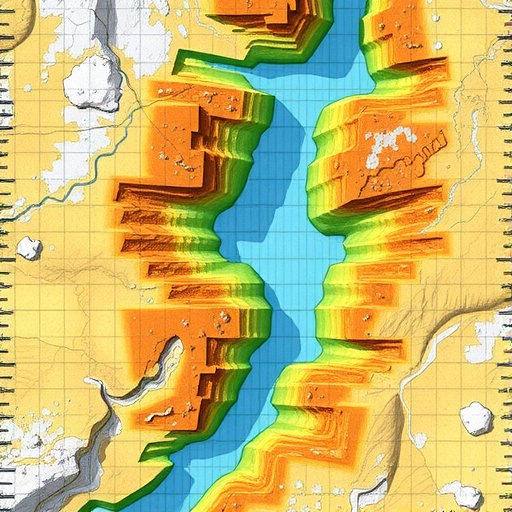In the hidden depths beneath the rugged terrain of Xujiagou, a complex and captivating story of water movement and mineral origins unfolds. Recent research led by Lin, He, and Wu has provided groundbreaking insights into the hydrochemical evolution of karst groundwater systems and the enigmatic sources of strontium isotopes permeating these subterranean waters. This study not only unravels the intricate geochemical processes shaping groundwater composition but also offers a window into the environmental history and ongoing transformations of karst aquifers, which are vital freshwater reservoirs worldwide.
Karst terrains, characterized by soluble rock such as limestone, develop intricate underground drainage networks that dramatically influence water chemistry. The Xujiagou region, a classic karst landscape, presents a natural laboratory where circulating groundwater interacts with lithological and climatic variables, shaping its hydrochemical fingerprint. Lin and colleagues embarked on a detailed investigation combining classic hydrochemical methods with cutting-edge strontium isotope analysis to trace the origin and evolution of groundwater within this complex system.
One of the study’s landmark achievements lies in its meticulous hydrochemical profiling of groundwater samples spanning different recharge zones and flow paths within Xujiagou. By analyzing major ion concentrations alongside strontium isotope ratios, the researchers could identify distinct stages of groundwater evolution. The data reveal that as water percolates through the karst matrix, it progressively acquires ions derived from rock dissolution, with significant variations in strontium isotope signatures reflecting changes in mineral interaction and aquifer lithology.
Strontium isotopes serve as invaluable tracers in hydrogeology due to their conservative behavior and variable abundance in different rock types. In the Xujiagou study, the isotopic composition indicated a mixture of contributions from carbonate dissolution, silicate weathering, and potentially anthropogenic inputs. The nuanced isotopic patterns uncovered through precise mass spectrometry underscore the complex interplay between geological substrates and groundwater chemistry, highlighting the spatial heterogeneity intrinsic to karst systems.
Equally compelling is the revelation that groundwater evolution in Xujiagou is not a simple, linear process but rather a dynamic sequence influenced by multiple recharge sources and variable residence times. Lin and colleagues demonstrated that some groundwater exhibits signatures indicating long residence times with extensive rock-water interaction, while other samples reflect more recent recharge with minimal chemical alteration. This finding is pivotal for water resource management, as it pinpoints vulnerable zones where rapid infiltration might introduce contaminants or shift water quality.
The research further delineates how seasonal fluctuations and climatic conditions modulate karst groundwater chemistry. The hydrochemical and isotopic data collectively show that changes in precipitation patterns and temperature influence recharge processes, dissolution rates, and overall aquifer dynamics. Such environmental sensitivity emphasizes the potential impacts of climate variability on karst groundwater quality and availability, a pressing concern given global climate change trajectories.
Another fascinating aspect explored is the spatial distribution of strontium sources across Xujiagou. Through spatial mapping of isotopic ratios and ion concentrations, the study identifies geochemical signatures tied to distinct lithological units within the karst matrix. Carbonate rocks contribute strontium with a characteristic isotopic fingerprint, while silicate minerals and weathered soils introduce variable signatures depending on their mineralogy. Disentangling these sources provides a refined understanding of aquifer material composition and its influence on groundwater chemistry.
The data also hint at possible anthropogenic influences inscribed within the groundwater system, although these are subtle compared to natural geochemical drivers. Elevated strontium levels in certain locales, combined with deviations in isotopic ratios from expected geological baselines, suggest inputs from agricultural activities or industrial effluents. This highlights the need for continued monitoring to safeguard karst groundwater quality in increasingly human-impacted environments.
Hydrochemical evolution within karst systems such as Xujiagou is therefore dictated by a delicate balance between natural geologic interactions and external environmental inputs. Lin and his colleagues’ integrative approach, merging hydrochemical indicators with isotopic tracers, sets a new standard for understanding these multifaceted processes. Their methodology could be adapted to other karst regions facing complex water quality challenges, enabling more effective groundwater management strategies globally.
Moreover, their study sheds light on the broader implications for strontium cycling in the environment. As strontium isotopes migrate through groundwater, they carry imprints of past geological events and ongoing chemical processes. This makes karst aquifers not only sources of freshwater but also archives of environmental change, an exciting prospect for future geochemical and paleoenvironmental research.
The powerful combination of field sampling, laboratory analyses, and geochemical modeling employed in this research underscores the necessity of interdisciplinary approaches in contemporary earth sciences. By bridging hydrogeology and geochemistry, Lin et al. have deepened our knowledge of karst groundwater complexities, offering critical insights for protecting these valuable but vulnerable water resources.
In conclusion, the detailed characterization of groundwater evolution in Xujiagou illuminates the remarkable dynamism within karst aquifers and the vital role of strontium isotopes as tracers of geochemical processes. This pioneering work not only advances scientific understanding but also informs practical efforts to preserve groundwater quality amid environmental change. As humanity grapples with water security challenges, such research underscores the extraordinary stories hidden beneath our feet and the crucial need to decipher them.
Subject of Research: Hydrochemical evolution of karst groundwater and strontium isotope sources in Xujiagou karst aquifers
Article Title: Analysis of karst groundwater evolution and strontium sources in Xujiagou: A hydrochemical and strontium isotope analysis
Article References:
Lin, Y., He, Ym. & Wu, Yz. Analysis of karst groundwater evolution and strontium sources in Xujiagou: A hydrochemical and strontium isotope analysis. Environ Earth Sci 84, 526 (2025). https://doi.org/10.1007/s12665-025-12553-1
Image Credits: AI Generated




